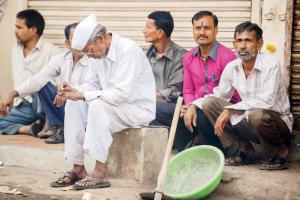A study of the impact of demonetisation on labourers in Thane reveals the harsh realities of the 'flawed' policy

Labourers waiting for work at one of the nakas in Thane. Contractors visit these nakas on a daily basis and select which worker they want to employ. Pic courtesy/ActionAid Maharashtra and Manoej Paateel
It was just days into demonetisation, which hit the country on November 8, 2016, when a construction labourer from Thane dragged his teenage daughter into an abandoned industrial unit. Here, with her head shrouded in a dupatta, she became the subject of a tiny bargain that was being negotiated by the unit's watchman with a client. When the deal had been sealed, her father had made R200 by selling her for a few hours. This horrifying account is just one of the many stories relayed to developmental economist Ritu Dewan, who undertook a first-of-its-kind study in the summer of last year, to measure the impact of demonetisation on the workers and construction labourers in the Mumbai Metropolitan Region.
ADVERTISEMENT
Turning to the nakas
The study has become the subject of Dewan's new book, Demonetisation: From Deprivation to Destitution, which she co-authored with researcher Radha Sehgal. One of the main reasons behind the survey, says Dewan, was that there was nothing available in terms of primary data to understand why demonetisation wasn't good for the economy. "There were some superb books and brilliantly-researched journalistic pieces being written on demonetisation, but they relied on secondary information. As an economist, you need to quantify any impact," says Dewan, who led the research with the help of six interns from St Xavier's College, Dhobi Talao, in April and May of last year — over a year after demonetisation happened.
The team hadn't expected the huge wave of "anger" that demonetisation brought with it. "It was not a hit-and-run event. There are things that they [labourers] will never, ever recover from," argues Dewan, also the vice-president of the Indian Society of Labour Economics. Her research puts their story into perspective. Dewan and team surveyed 227 workers (125 men and 102 women) from eight construction nakas — Shivaji Chowk No 1, Mumbradevi, Shahad East, Morivali, Kapurbawdi-Thane West, Manpada, Khemani and Dhamankar — in the Thane district. These nakas are fixed places where construction workers stand and wait every day to find work. "The contractors come to these nakas and select workers."

Ritu Dewan
There were two main reasons behind choosing these particular nakas, says Dewan. First, maximum number of constructions were apparently taking place in this area as there was a major shift of population to this location; second, most of the nakas located in this district, represent an amalgamation of both local and migrant workers. Split into three phases, the survey highlights the ground truths of PM Narendra Modi's policy.
Far-reaching impact
Demonetisation became an easy excuse to reduce the wages of labourers; if nothing else, they were given the old R500 notes and expected to exchange it on their own. In some cases, industrial units shut down, and jobs were no longer available. "One of the immediate impacts of this was that several workers had to remove their children from school as they just didn't have the money for the mid-term fees. Girls, in particular, were taken out of school for three to four months together, which meant they had to skip the entire year. Many kids were also transferred from private to municipal or vernacular schools," says Dewan. There was also a significant percentage of people, who no longer had access to hospitals or healthcare. In fact, 31 workers reported absolute non-use of medicines during the three months after demonetisation.
But the single most distressing fall-out of demonetisation, writes Dewan, was the drastic decline in basic nutritional levels. An appalling 63 per cent of these 227 households had to reduce their basic nutritional levels in the first three months. "They were not even eating one meal a day," she says. While the langars at gurdwaras were succor for many, Dewan points out how kirana store owners, who'd take the Aadhar card as collateral — making many fear that they'd lose their citizenship — would also take advantage of women, sometimes on the pretext of giving them extra grain.
"Post demonetisation, sexual violence had become a pre-condition for employment. I have seen it with my own eyes, how at nakas, the more undernourished and less undernourished women would be standing in different queues. They were being asked point-blank, if they would sleep with the contractors. It was tragic," says Dewan, adding that worse was fathers and brothers confessing to her, about selling their daughters and sisters for Rs 200-300. Dewan says "this research can be extended to all informal urban sectors" across the country. "As economists, we know that demonetisation failed in every possible way. There should have been greater state responsibility of giving and not taking away."
Catch up on all the latest Mumbai news, crime news, current affairs, and also a complete guide on Mumbai from food to things to do and events across the city here. Also download the new mid-day Android and iOS apps to get latest updates
 Subscribe today by clicking the link and stay updated with the latest news!" Click here!
Subscribe today by clicking the link and stay updated with the latest news!" Click here!







